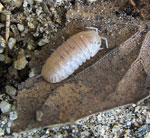Jonathan Wright
Southern California Oniscidea
I am including some brief notes here for people interested in the land isopods of Southern California. These animals remain poorly studied and under-recorded in America generally, and amateur naturalists and professional biologists alike can make important contributions to our understanding of local species distribution and ecology. I am compiling a recordings scheme for Southern California and appreciate any records that people are able to contribute. Where possible, please include species names, location where these were found (including grid reference and habitat details), dates, and any other relevant information. If you are uncertain of a species’ identity, please send me specimens preserved in 70% ethanol. Species confirmation frequently relies on examination of the male pleopods, so it helps to send males or, if the sex is unknown, 3-4 specimens. Please do not over-collect and please remember never to take animals from national or state parks, wilderness areas, designated wildlife refuges, or other protected areas.

Venezillo arizonicus
The most familiar land isopods of Southern California are European introductions. These include Armadillidium vulgare (the ‘rolypoly’), Porcellio dilatatus, Porcellio laevis, and Porcellionides floria. Only 4 native species have been recorded inland, and none of these is commonly found. Venezillo microphthalmus is rare on the mainland, although it has been previously recorded from the Channel Islands (Garthwaite et al. 1985). Based on this species’ apparent decline in the San Francisco Bay area (Arcangeli, 1933; Garthwaite et al., 1992) it may be undergoing displacement by introduced species. Venezillo arizonicus is another poorly known and scantly recorded species, and is the only isopod native to the southwestern deserts. I have found this species in two locations in the Coachella Valley. Ligidium lapetum, like congeneric species, is strongly hygric and confined to riparian fringe habitats. L. lapetum occurs in several of the permanent water drainages of the San Gabriel Mountains, in spite of its being recorded only twice in the literature from Marin and Santa Barbara Counties (Mulaik and Mulaik, 1942; Schultze et al., 1982). I have also found this species in coastal Douglas fir forests in southern British Columbia. The fourth native species recorded from interior Southern California is a minute soil-dweller. Brackenridgia heroldi has been recorded sporadically in the literature, having been collected from several counties in Central California (Garthwaite and Lawson, 1992), and from two recordings in Southern California from Riverside and San Bernardino Counties (University of California Insect Survey). I have recently (2009, 2010) found this species in two locations in Los Angeles Co.
The Oniscidea are generally poorly protected against desiccation when compared to insects and arachnids. For this reason, they are often synanthropic, and many introduced probably species underwent rapid range expansion in the late 19th and early 20th century, exploiting irrigation ditches and garden sprinklers in more arid areas. In Southern California, it is remarkable that one of our native species, Venezillo arizonicus, occurs in the Colorado and Sonoran Deserts — among the hottest and driest deserts in the country. But given the relative aridity of the southern California floristic provinces, it is not surprising that most of our native species are associated with marine littoral habitats. Three of these, Alloniscus perconvexus, A. mirabilis, and Tylos punctatus, are sand-burrowers that emerge to the surface at night to feed on beached algae. The others, including the large and common sea roach Ligia occidentalis, are found typically in the upper intertidal and supra-littoral habitats of rocky shores.
Literature Cited:
- Arcangeli, A. (1932). Isopodi terrestri raccolti dal prof. Silvestri nel Nord-America. Boll. Lab. Zool. Gen. Agra. Portici 26, 121-141.
- Garthwaite, R.L., and Lawson, R. (1992). Oniscidea (Isopoda) of the San Francisco Bay area. Proc. Cal. Acad. Sci. 47(11), 303-328.
- Garthwaite, R., Hochberg, F.G., and Sassaman, C. (1985). The occurrence and distribution of terrestrial isopods (Oniscoidea) of Santa Cruz Island with preliminary data for the other California islands. Bull. S. Cal. Acad. Sci. 84, 23-37.
- Mulaik, S., and Mulaik, D. (1942). New species and records of American terrestrial isopods. Bull. Univ. Utah. 32, 1-23.
- Schultze, G., Gathwaite, R.L., and Sassaman, C. (1982). A new family placement for Mauritaniscus littoralis (Miller) n. comb. From the west coast of North America with ecological notes (Crustacea: Isopoda: Oniscoidea: Bathytropidae). Wasmann J. Biol. 40, 77-89.
Check-list of Southern California Oniscidea
- Section Diplocheta
- Family Ligiidae
- Ligia occidentalis Dana, 1853
- Ligidium lapetum Mulaik and Mulaik, 1942 [another photo]
- Family Ligiidae
- Section Tylida
- Family, Tylidae
- Tylos punctatus Holmes and Gay, 1909 [another photo]
- Family, Tylidae
- Section Synocheta
- Family Trichoniscidae
- Haplophthalmus danicus Sars, 1899
- Brackenridgia heroldi(Arcangeli, 1932)
- Family Trichoniscidae
- Section Crinocheta
- Family Alloniscidae
- Alloniscus perconvexus (Dana, 1856)
- Alloniscus mirabilis (Stuxberg, 1875)
- Family Detonidae
- Armadilloniscus holmesi Arcangeli, 1933
- Armadilloniscus lindahli (Richardson, 1905)
- Family Platyarthridae
- Niambia capensis (Dollfuss, 1895)
- Family Armadillidae
- Venezillo arizonicus (Mulaik and Mulaik, 1942)
- Venezillo microphthalmus (Arcangeli, 1932)
- Family Porcellionidae
- Littorophiloscia richardsonae (Holmes and Gay, 1909)
- Porcellionides floria Garthwaite and Sassaman, 1985
- Porcellio dilatatus Brandt and Ratzeburg, 1833
- Porcellio laevis Latreille, 1804
- Porcellio scaber Latreille, 1804
- Family Armadillidiidae
- Armadillidium vulgare (Latreille, 1804)
- Family Alloniscidae